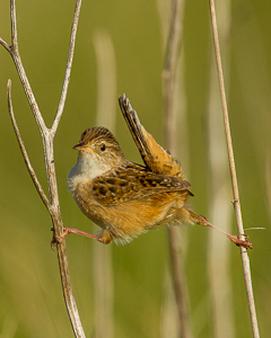SEDGE WREN KY-121
Western Kentucky: just outside Sebree
May 23, 7:15 a.m.
Sunrise at 5:34 a.m.
A sedge wren! And in May! The records show that sedge wrens often head far to the north and return to breed in Kentucky only during July or later, but here they are, three of them singing in this old field just outside of Sebree, Kentucky.
Sedge wrens and I have a history together. I have traipsed all over the New World trying to understand them, from throughout North America through Central and South America to the Falkland Islands. They're special, because they don't imitate their songs like the other wrens I know; instead, they improvise their songs, each male coming up with a unique song repertoire of 100 or more songs. They improvise their songs, I believe, because they don't stay in one place to breed and become part of a local community, and there is therefore no "need" to imitate songs of one's neighbors.
When singing during the day and uninspired, so to speak, a male will repeat a song many times before switching to another in his repertoire. This sedge wren does that, but he's oh so devious, because the songs that he chooses here are especially similar to one another and difficult to detect; I had to look at the sonagrams to hear them. But you be the judge. Perhaps your ears are better than mine. So I'll tell you that this male introduces new songs at 1:03, 1:46, and 2:15. Can you detect the transition from a series of one song to another at those times? If so, good on your ears!
After a series of calls from a male red-winged blackbird, this sedge wren provides a single example of another song at 3:41. He has perhaps another hundred or more!
Last, I provide a little help for our ears. I've excerpted one example of each of the four songs and now play them back to back. Now it's a little easier to tell them apart:
Then I take the ending trills for each song, put them back to back, and slow them to one quarter speed, lowering the frequency in the process; now we can hear the differences in the four songs more easily:
Background
Tufted titmouse (two males match each other with identical songs), red-winged blackbird males respond to each other with identical local calls (listen especially beginning at 0:46; and there's another series of that call from one male beginning at 3:16), eastern towhee, several nice examples of northern flicker wik-wik-wik song (e.g., 0:30), indigo bunting, a second sedge wren in the distance, field sparrow, eastern wood-pewee in the nearby forest, heavy equipment in reverse, barking dog.

Photo by Wil Hershberger
